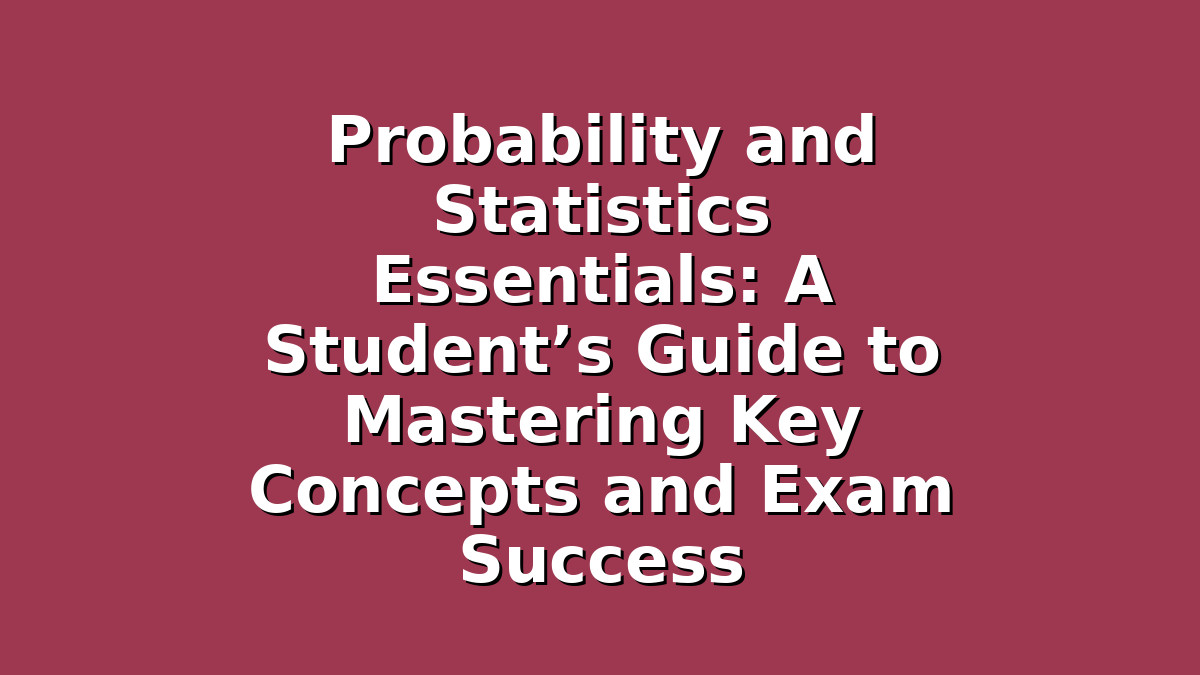Preparing for exams in probability and statistics can feel overwhelming, especially when faced with a mix of formulas, theories, and real-world applications. However, understanding the essentials of these subjects not only helps you excel in exams but also equips you with critical analytical skills useful in many fields. Whether you’re a high school student, a college freshman, or someone brushing up before an important test, this guide breaks down the core concepts and offers practical study tips to help you gain confidence and improve your performance.
Understanding the Foundations: Key Concepts in Probability and Statistics
Before diving into formulas or problem-solving, it’s crucial to grasp the fundamental ideas that form the backbone of probability and statistics.
– Probability Basics: Probability measures how likely an event is to occur and is expressed as a number between 0 (impossible) and 1 (certain). Key terms include:
– *Experiment:* A process that leads to well-defined outcomes.
– *Sample Space:* The set of all possible outcomes.
– *Event:* A subset of outcomes from the sample space.
For example, when rolling a six-sided die, the sample space is {1, 2, 3, 4, 5, 6}. The probability of rolling an even number is the number of favorable outcomes (2, 4, 6) divided by total outcomes, so 3/6 = 0.5.
– Descriptive Statistics: This involves summarizing and describing data using measures like:
– *Mean:* The average of data points.
– *Median:* The middle value when data is ordered.
– *Mode:* The most frequently occurring value.
– *Variance and Standard Deviation:* Measures of data spread around the mean.
– Inferential Statistics: Going beyond description, inferential statistics uses sample data to make generalizations or predictions about a larger population. Techniques include hypothesis testing, confidence intervals, and regression analysis.
Study Tip: Create flashcards for key terms and definitions. Repetition helps reinforce understanding and makes recalling these basics easier during exams.
Mastering Probability Problems: Approach and Practice
Probability requires both conceptual clarity and problem-solving skills. Many students struggle because they try to memorize formulas without understanding when and how to apply them. Here’s how to study effectively:
1. Visualize Problems: Use diagrams like tree diagrams, Venn diagrams, or tables to map out the problem. Visualization helps clarify complex event relationships, such as independent vs. dependent events or mutually exclusive events.
2. Identify the Type of Probability: Is it a simple probability, conditional probability, or a probability involving combinations and permutations? Recognizing this early guides your method.
3. Understand Probability Rules:
– *Addition Rule:* For mutually exclusive events, P(A or B) = P(A) + P(B).
– *Multiplication Rule:* For independent events, P(A and B) = P(A) × P(B).
– *Complement Rule:* P(not A) = 1 – P(A).
4. Practice Word Problems: Exam questions often present probability scenarios as stories. Practice translating written problems into mathematical expressions.
Study Tip: Dedicate time daily to solve varied probability problems. Use past papers or online resources. After solving, review mistakes carefully to understand where you went wrong.
Tackling Statistics: Data Interpretation and Analysis Skills
Statistics is about making sense of data, which is a skill that improves with active engagement and practice. Here’s how you can deepen your grasp:
1. Practice Calculations by Hand and With Software: Start by computing mean, median, mode, variance, and standard deviation manually to understand the mechanics. Then, use tools like Excel, R, or calculators to speed up analysis for large datasets.
2. Understand Graphical Representations: Histograms, box plots, scatter plots, and pie charts visually represent data and reveal trends or outliers. Being comfortable interpreting these can help you quickly answer exam questions.
3. Learn to Formulate and Test Hypotheses: Understand the logic behind null and alternative hypotheses, significance levels, p-values, and confidence intervals. Work through practice problems involving hypothesis tests to see how data supports or rejects a claim.
4. Make Connections: Link descriptive statistics to inferential conclusions. For example, knowing the sample mean and standard deviation helps estimate the population mean with a confidence interval.
Study Tip: Form a study group where you can discuss statistical concepts and explain them to each other. Teaching a peer is one of the most effective ways to solidify your knowledge.
Exam Preparation Strategies for Probability and Statistics
Success in exams is not just about knowing content but also about managing time, reducing anxiety, and applying knowledge smartly.
– Create a Study Schedule: Break your revision into manageable chunks focusing on different topics each day. Include time for practice problems and review.
– Use Past Exam Papers: Familiarize yourself with the exam format and question types. Simulate exam conditions by timing yourself.
– Memorize, but Don’t Rote Learn: Understand why formulas work rather than just memorizing them. For example, know how the binomial probability formula is derived and when to use it.
– Clarify Doubts Early: Don’t wait until the last minute. Reach out to teachers, tutors, or online forums whenever a concept is unclear.
– Stay Positive and Take Breaks: Regular breaks during study sessions help improve focus and retention. Keep a positive mindset; confidence often translates into better performance.
Study Tip: On exam day, start with questions you feel most confident about. This boosts morale and helps you manage time effectively for more challenging problems.
Conclusion
Probability and statistics might seem daunting at first, but with steady practice and a clear understanding of fundamentals, you can master these essential subjects. Focus on building your conceptual framework, practice diverse problems, and adopt smart study habits. Remember, the skills you develop here will not only help you ace your exams but also prepare you for real-world decision-making and data analysis in the future. Stay curious, stay consistent, and trust your ability to succeed!

Responses